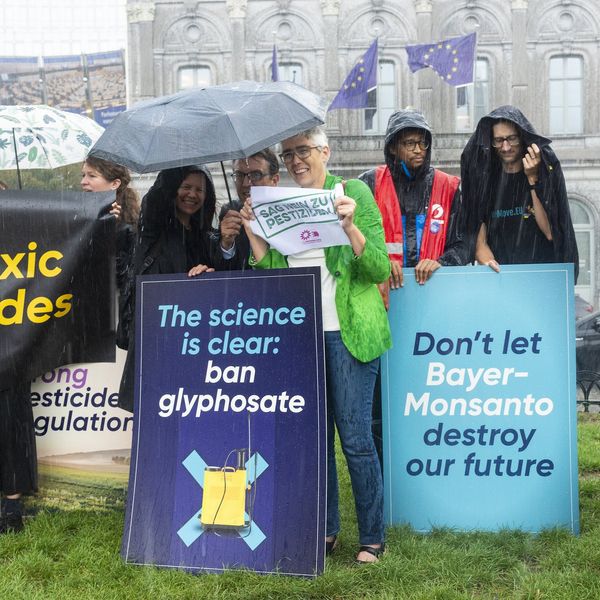In 1996, Congress ordered the U.S. Environmental Protection Agency (EPA) to test all pesticides used on food for endocrine disruption by 1999. The EPA still doesn’t do this today.
Nor does it appear close to doing so, argue the plaintiffs in a lawsuit filed against the agency in December for its ongoing failure to implement the Endocrine Disruptor Screening Program.
“As of the time of this filing, more than 25 years after the passage of the Food Quality Protection Act, [the] EPA has yet to implement the Endocrine Disruptor Screening Program it created and further, has failed to even initiate endocrine testing for approximately 96% of registered pesticides,” the lawsuit states.
Experts say such screening is vital to protect people’s health as endocrine-disrupting chemicals — compounds that can block, mimic or interfere with the proper functioning of hormones — have been linked to a variety of health problems including obesity, diabetes, respiratory issues, some cancers and negative impacts on the nervous, reproductive and immune systems.
However, other than a draft white paper updating a single aspect of the program this January — coincidental timing, EPA deputy assistant administrator for pesticide programs Ya-Wei “Jake” Li told EHN — the Endocrine Disruptor Screening Program has appeared dormant since 2015.
That year, almost two decades after its inception, the program released its first batch of test results. Among 52 pesticides screened for endocrine-disrupting activities at the time (a tiny fraction of the more than 1,300 pesticides now registered by the EPA), 18 were found to warrant additional testing. But that testing never occurred, and those pesticides are still in use.
Li said the January white paper, which proposes two new test methods that don’t rely on animal assays, is an important milestone. He also promised “more to come later this year.” However, other than citing unsuccessful attempts by the Trump administration to defund the Endocrine Disruptor Screening Program, he didn’t comment on why it’s taken so long to get it off the ground.
“This is a program that’s been ignored for 25 years, essentially,” Pegga Mosavi, a lawyer with Washington, D.C. nonprofit Center for Food Safety, told EHN. The Center for Food Safety brought the new lawsuit against the EPA with fellow plaintiffs Alianza Nacional de Campesinas, Organización en California de Líderes Campesinas, Rural Coalition, Pesticide Action Network North America and Center for Environmental Health.
“We started looking into it last summer and recognized just how egregious the entire issue was,” Mosavi said. “It’s impacting so many people, specifically a lot of people [represented by] our clients. Farmworkers are incredibly vulnerable, since they are the most directly exposed to pesticides via their occupation, but there’s also concern of exposure via food and drinking water.”
Past lawsuits over the Endocrine Disruptor Screening Program
This isn’t the first suit to be brought against the EPA over the Endocrine Disruptor Screening Program. In 1999, the nonprofit Natural Resources Defense Council (NRDC) sued the agency for failing to meet its deadline of launching the program that year. The case was settled when the EPA committed to new deadlines and agreed to send progress reports to the NRDC, which the agency did.
Related: Communities on the front lines of pesticide exposure fight for change
In 2005, the nonprofits Physicians Committee for Responsible Medicine and People for the Ethical Treatment of Animals sued the agency over its continued mishandling of the program and failure to meet new statutory deadlines. That suit was dismissed the following year when the court ruled that the plaintiffs lacked standing.
EPA points to progress
Another 15 years passed. Then came a report from the EPA Office of Inspector General — an independent oversight organization within the agency that performs audits, evaluations and investigations — concluding the program had made “limited progress,” had not performed required testing and lacked an effective system of internal controls.
The report also outlined 10 new recommendations with 10 new deadlines, which EPA staff agreed to — but again, in multiple instances, proceeded to miss. The white paper released for public comment in mid-January was supposed to be out by the end of 2021.
Nevertheless, Li, who joined the EPA in 2021 after serving in leadership roles at the nonprofits Defenders of Wildlife and Environmental Policy Innovation Center, told EHN that publication of the document — the program’s first official action in nearly eight years — constitutes a critical turning point.
“The important takeaway from the white paper is that it will help us to expedite implementation of the [screening program],” he said. “We see this science as important to helping us speed up implementation … so that we can take the necessary protective measures for human health and wildlife.”
“The program is failing”
The program’s budget for fiscal year 2023 is $7.61 million, up from $7.57 million in 2022 and $7.5 million in 2021. But funding alone doesn’t tell the story, Li admits, and the Inspector General report confirms: in prior years, some program staff were instructed to “treat the Endocrine Disruptor Screening Program as if [it] had been eliminated from the EPA’s budget even though Congress funded the program.”
The inability of the program to accomplish its federally mandated goals is more than a legal technicality, University of Massachusetts environmental health scientist Laura Vandenberg told EHN. Vandenberg, along with environmental consultant Maricel Maffini, coauthored a 2022 article in the journal Frontiers in Toxicology on the program’s long-running impotence.
Independent testing in Vandenberg’s lab and elsewhere has already confirmed endocrine-disrupting activity in many of the compounds in question, she said. “We know that there are chemicals being used in pesticides that are endocrine disruptors. I already have the answers for a lot of these chemicals, and the fact that they have yet to determine that they are endocrine disruptors is evidence that the program is failing. The ultimate goal is protecting the public, improving the science and holding the agency and the producers responsible.”
If past rulings are any guide, the inclusion of plaintiffs like the Berkeley-based Pesticide Action Network of North America (PANNA), which represents farmworkers and residents of rural communities who are most heavily exposed to pesticides, could make the new lawsuit more effective at securing these goals than previous legal actions.
“One of [our] issue areas is in gaining greater health protections for those disproportionately impacted by pesticides,” PANNA staff scientist Emily Marquez told EHN. “[We] joined this lawsuit with the Center for Food Safety to hold EPA accountable — and shed light on these dangerous compounds.”
- Jennifer Liss Ohayon: Why is the EPA still exposing women to pesticides linked to breast cancer? ›
- The uphill battle for communities that ban pesticides ›
- What are pesticides? ›
- On the frontlines of pesticide exposure ›
- Adrift: Communities on the front lines of pesticide exposure fight for change ›
- A lingering Trump-era regulatory trick could push orcas, salmon to extinction - EHN ›





























